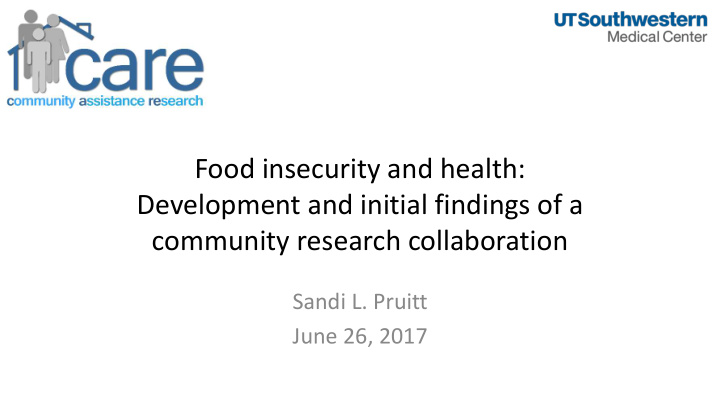



Food insecurity and health: Development and initial findings of a community research collaboration Sandi L. Pruitt June 26, 2017
Reduction of food insecurity, particularly at the severe level, is a public health concern and a modifiable structural determinant of health worthy of macro-level policy intervention Jessiman-Perreault, G & McIntyre, L. SSM-Population Health, 2017; 3:464-72.
Food insecurity and health • Food insecurity associated with worse health & health behaviors & less healthcare access • Food assistance improves health – Most evidence about SNAP/WIC – What about food bank assistance? • 22% of food insecure US adults receive food bank assistance (58% receive none) Seligman et al, 2007; Stuff et al, 2004; Pruitt et al, 2016; Pruitt et al, 2015; Gundersen et al, SNAP Matters, 2015
Community-academic partnership Service providers Health Researchers, researchers, students physicians
• Formative work is hypothesis-generating and inspires action Formative, mixed • Population monitoring methods – Representative, longitudinal, community- owned, data collection Population monitoring • Hypothesis testing – Evaluate population Hypothesis changes testing, – Evaluate impact of policy statistical changes nationally, inference regionally, institutionally
2016 engagement metrics • 183 onsite contact hours • 300 intern hours • 200 data collection hours • 11 training hours • 136 participants primary data collection • 15,039 individuals secondary data analysis
Population monitoring • 12-15K unique individuals; ~5000 households / year • Monthly, opportunistic data collection at pickup for 6,000 individuals / year – Food & economic security – Residential mobility – Health: direct BMI measurement, self- reported health, diabetes, HBP, social support Community Distribution Partners across Dallas • Data linkage County, 880 square miles – Safety-net EMR – Housing appraisal data
Food security by race/ethnicity (n=2,364; 61% Hispanic) 100% 90% High Food Security 80% 70% Marginal Food Security 60% 50% 40% Low Food Security 30% 20% Very Low Food Security 10% 14.8% 44.3% 0% Hispanic African American
Monthly Food Security: Hispanic 60 50 Percent of Clients 40 High Food Security 30 Marginal Food Security 20 Low Food Security Very Low Food Security 10 0 Population monitoring snapshot July 2015- Month of Survey March 2017 Monthly Food Security: African American 60 50 Percent of Clients 40 30 High Food Security Marginal Food Security 20 Low Food Security 10 Very Low Food Security 0 Month of Survey
Qualitative Research • 8 Focus groups (4-9 persons each) – 4 in English, 4 in Spanish – N=47 adult clients, 81% female, 90% Hispanic and African American • Audio-recorded, transcribed • Questions and probes focused on health and economic status, daily living challenges • Analysis: themes identified by frequency and qualitative emphasis; excerpts selected from transcripts illustrating themes; Nvivo 9.0
Theme 1: Mutually reinforcing problems Anxiety about health of other household members From one to Worry about impacts of unstable health and economic many and circumstances across all members of the household many to one in the When it affects one, it affects household all in the family. I’m in this situation and I have to do the best, but I’m concerned mostly about health issues because all of us [in household] have issues that could take us out, you know… I mean die …
Theme 2: What I get from here I sometimes send to Mexico to my mom. Because she's alone. Every month Food-sharing that I come here I make her a box and I send it to her, because I know she's all by herself and needs it. They [two neighbors] don't have a job; they've had to do without their husband. Sometimes they don't even have anything to feed their children. A can, pasta, a bag of beans, it helps us to share with someone. Truth is that it helps us and it helps us to help someone else.
• Food, health, economic circumstances are Conclusions shared across household, family, social networks • Optimizing food bank assistance to improve health will require: – Cross-sector collaboration – Measurement at multiple levels: individual, family, household, social network – Mixed methods – New analytic approaches for opportunistic, messy data – Passion, patience, and resources
Thanks to all our researchers, teachers, staff, students, families, and volunteers Tammy Leonard, PhD Sandi Pruitt, PhD Lisa Quirk, MS, MPH Robin Higashi, PhD Xia Si David Andrews, PhD Economics Public Health Project Coordinator Medical Anthropology PhD Student Mathematics University of North UT Southwestern UT Southwestern UT Southwestern Economics University of Dallas Texas Medical Center Medical Center Medical Center University of Texas Dallas Carla Pezzia, PhD Oanh Nguyen, MD Stephanie Swales, PhD Juan Mijares Amy Hughes, PhD Medical Anthropology Internal Medicine Psychology Project Coordinator Geographic Information Sciences University of Dallas UT Southwestern University of Dallas UT Southwestern UT Southwestern Medical Center Medical Center Medical Center
Questions? http://www.udallas.edu/care/
Recommend
More recommend